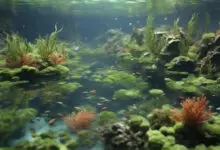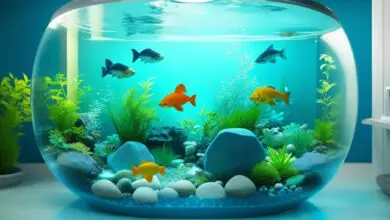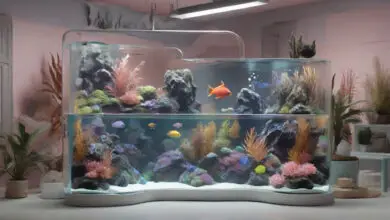The Ultimate Guide to Natural Filtration

Filtration is very important for good aquarium health. Filters remove waste and balance chemicals. Most tanks use special machines outside the tank to filter water. But plants can also filter water naturally inside the tank. Using live plants is a popular filtration choice.
Plants help tanks in many ways. They provide food, shelter and comfort for fish. Plants also give beauty and decor. But one of the biggest benefits is water filtration. Plants clean chemicals and absorb nutrients that would grow bad algae.
They allow owners to run weaker filters or do fewer water changes. Natural filtration from plants creates very healthy stable tanks.
How Plants Help Filtration
Plants improve water in many filtration ways. They:
- Take in fish waste like ammonia, nitrite and nitrates
- Add oxygen to water from photosynthesis
- Absorb and block excess nutrients that feed algae
- Release helpful chemicals and hormones for fish health
- Provide surface area for good bacteria to grow on
Having many plants is like adding extra strong natural filters. The plants, roots and bacteria handle chemicals so fish stay happy. Less tank maintenance is needed overall with robust plants helping out the filtration work.
Types of Aquarium Plants
Many kinds of aquatic plants work well in home fish tanks. Each looks a little different and offers slightly different benefits. Having a mix provides full natural filtration.
Easy Beginner Plants
Some plants grow fast and easy for starter planted tanks. They tolerate a range of light, nutrients and care. These forgiving plants help new owners succeed with natural filtration.
Examples include:
- Anubias
- Java Fern
- Hornwort
- Anacharis
- Java Moss
- Marimo Moss Balls
- Amazon Sword
- Cryptocorynes
These beginner species filter well without much special care. They clean water nicely while owners learn more about aquatic gardening.
| Plant Type | Filtration Benefits | Care Level Needed |
|---|---|---|
| Floating Plants | Fast growing, nutrient absorbing, provide shaded areas | Low – can thrive in most tanks |
| Moss Plants | Dense growth houses bacteria, absorbs waste | Low to Medium – attach to decor |
| Rooted Stem Plants | Moderate growth and nutrient use | Medium – need root fertilization |
| Advanced Aquascaping Plants | Very fast growing, nutrient absorbing | High – require strong light and fertilizer |
These beginner species filter well without much special care. They clean water nicely while owners learn more about aquatic gardening.
Advanced Aquascaping Plants
Other plants have higher needs but give amazing results. Advanced owners use these in artistic aquascaped layouts. The plants grow dense if given strong light and fertilizer dosing.
Harder but rewarding species include:
- Dwarf Hairgrass
- Glossostigma
- Monte Carlo
- Pogostemon Helferi
- Alternanthera Reineckii
- Rotala Wallichii
When grown well, these species filter tanks spotless. But their fast growth needs trimming often. Aquascapers shape them into underwater scenes with dense filtration capacity.
Floating Plants
Floating plants are very easy filtration aids. They get light from above water so owners need not focus special lights on them. They grow fast to filter and break line of sight for shy fish.
Some top options are:
- Frogbit
- Dwarf Water Lettuce
- Salvinia Minima
- Duckweed
- Water Spangles
These floaters multiply readily if given excess nutrients. So they beg nutrient algae thrives on. Trimming extras helps keep tanks crystal clear.
Moss Plants
Mosses make up some of the best natural filtration options. They grow in thick bushy mats with massive surface area for bacteria. And many fish species love resting in or laying eggs within moss walls.
Top mosses consist of:
- Java Moss
- Christmas Moss
- Flame Moss
- Fissidens Fontanus
- Peacock Moss
- Taiwan Moss
Java in particular attaches well to hardscape material like wood or rocks. This creates ideal bacterial housing that clears tons of fish waste. Tanks feel healthier and more natural with moss clumps helping filter.
Benefits of Plants for Filtration
Plants improve tanks in many positive ways beyond just filtration. But specifically for cleaning water, they provide huge advantages. Plants are powerhouse miniature filters able to transform tank environments.
Natural Chemical Removal
Machines cannot perfectly replicate nature’s filtration abilities. Plants utilize chemicals so efficiently that levels stay balanced on their own. Tanks feel tranquil and healthy rather than processed mechanically.
As examples, floating plants can reduce nitrates to near zero on their own. And mosses convert ammonia before it even reaches monitors. Relying on natural powers brings a stability technology alone often lacks long-term.
Surface Area for Beneficial Bacteria
Plants hugely raise usable space for good bacteria to live on. More bacteria means faster conversion of waste to safer chemicals. And additional specialized species can thrive in the plant root zones other than standard filters offer.
With dense planting, biological filtration capacity rises exponentially. The plant and bacteria team handles exponentially more fish or nutrients without issues. Very heavily stocked or fed tanks rely on flora to expand bacterial filtration.
Alleviating Algae
Algae struggles to get light or nutrients when plants thrive. The algae spores instead starve and fail to bloom with faster growing plants dominating. Red algae especially struggles to form with green refuge blocking light everywhere.
Plants beat algae at its own photosynthetic game. Robust green growth keeps glass spotless without scrubbing. Reducing maintenance this way makes balancing planted tanks worthwhile.
Oxygenation
Photosynthesis from plants unleashes bountiful oxygen into tank water with each daytime light exposure. This fish-friendly gas gets used up overnight by life processes. Daytime replacements from plants avoid suffocation issues.
Advanced tanks misted with CO2 gas for plant growth can lack oxygen without air pumps running too. Extra release from flora avoids this risk. Having renewable oxygen factories via plants maintains higher water quality.
Setting Up Low-Tech Planted Tanks
Heavy filtration plants thrive best in soils with added fertilizer. But basic species still improve water in simple setups greatly. Even jars sustain floating plants or clumps of moss as superb tiny natural filters.
Low Light
Not all tanks house strong aquarium lights, especially roomy low-tech ones. But direct or indirect sunlight through windows alone grows certain plants well. Anubias, mosses and java fern manage in shadows too.
Floating plants filter water in nearly any ambient room lighting without issue. Directing their flow to lower spots shares energy for bottom plants.
Low light plants clean decently when given non-enriched gravel or sand subsrate. Root tabs added periodically provide some micronutrients too. Though growth stays slower and thinning without strong light, plants filter basically with minimal intervention.
No Fertilization Needed
Plant-based water filtration happens even without adding fertilizer to substrate. Unenriched gravel sustains java species for years with nominal maintenance trimming. Anubias ties to rocks or driftwood filter fine without special nutrition aside from fish waste.
Fertilizer does allow fuller growth and thus higher filtration capacity. But for starters, plants help water conditions even without it. Floaters and mosses especially thrive on fish waste alone. This makes simple improving tanks easy via living filtration. Owners can add root dosing later once committed fully to underwater gardening.
Affordable Filtration Boosting
Fancy filtration supplements cost money and require balancing input flow. Plants offer filtration help at very low startup costs instead. Grab a tissue culture cup of java at the pet store for five dollars. Fishing line ties it to a decoration, no other gear needed.
Or scoop free floating duckweed from an outdoor pond into a jar. When back home, pour it into a tank and enjoy some natural waste consumption beginning. See if plant life fits your tank before upgrading filtration machines.
Growing Demanding Aquarium Plants
Basic flora filters water fairly with minimal intervention. But lush green walls that sparkle require meeting higher plant needs. For those committed to the underwater gardening side of fishkeeping, giving plants their required care takes tanks to the next level.
Proper Aquarium Lighting
Without lamp upgrades, plants often fail or stay stringy and pale. Proper watts of full spectrum output fuels lush plant growth. Submersible LED fixtures now output incredible light energy for aquascaped arrangements.
Light drives photosynthesis and nutrient transport in plants. Low light causes them to shed leaves, melt away or lose color without enough energy to function. They then lose filtration capacity and tank beauty.
Enriched Substrate
Plants absorb some fertilizer through roots, but plain gravel lacks any. Laterite clay, specialty branded soils, or soil topped sand gives full nutrition for lush growth. Root feeder crypts and carpeting stems depend on iron and micronutrients reaching roots.
Enriched substrates allow much faster plant mass and thus filtering ability accumulation. Rather than just sustaining, plants explode with health to keep water in top form.
Added Fertilization
Even with high light and improved substrates, tanks need water column dosing eventually. This adds key chemicals like nitrogen, potassium and phosphorus missing from fish waste. Reducing these avoids starving plants so they filter optimally.
Commercial all-in-one mixes like Thrive or NilocG Aquatics’ products fertilize beautifully. Following their initial dosing and maintenance schedules keeps plants thriving. Alternately owners mix dry salts for ultimate customization.
Proper fertilization powers filtering and beauty possible from aquarium flora. Avoiding deficiency supports the plants support for our tanks in return.
Maintenance Needed for Plant Filtration
Once set up for success, plant life keeps water clean and balanced naturally. But some easy repeated maintenance helps them continue doing so flawlessly for years on end. Keeping growth trimmed avoids blocking light or flow over time.
Thinning Overgrowth
Fast growers like hornwort or guppy grass overtake tanks quickly when thriving. Even slower growers like anubias eventually cluster in the way. Trimming plant mass every few months avoids suffocating the helpful organisms.
This also allows light to keep reaching the lowest parts of tanks. Shaded plants lower down fail to photosynthesize, dropping oxygen movement and root zone bacteria. Thinning lets everyone continue contributing best filtration abilities.
Owners should remove trimmed healthy portions for reuse elsewhere propagating plants. Excess trimmings often find new life in outdoor ponds or indoor jars getting upgraded.
Surface Skimming
Floating plants grow exponentially when thriving, forming dense interactive mats. This blocks gas exchange from water and chokes flow too much for some filters. Pooling leaves also rot, losing filtration capacity.
Every week, owners should net out excess floater clumps. Compost the trimmings or spread extras to additional tanks. This keeps O2 and CO2 movement healthy along with steady filter turnover. Dense patches remain to provide natural waste consumption still.
Glass Cleaning
With full enriched conditions, many aquarium plants shed some leaves or bloom copiously. Dying vegetation and petals settle on tank walls eventually. This covers the pretty underwater scenes created and blocks lower plants from getting light.
Gentle glass scrubbing removes buildup during weekly maintenance. Letting too much gather is unsightly and reduces filtration contribution from struggling buried plants. Tanks feel fresh again when visitors can admire aquascape designs clearly.
Keeping plant trimming and cleanup simple allows their filtration benefits continuing strongly. A little caretaking goes a long way for natural waste processing.
Conclusion
Technology improves but still does not match all the powers of aquatic flora for processing fish waste. As engineers understand biological filtration better, designs close the gap slowly. But plants adapt to utilize nutrients and toxins so much more ingeniously still.
Harnessing natural cleaning via common aquarium plants saves money over expensive equipment. And tanks thrive more fully when less disrupted biologically from artificial sources. Newer owners also find great joy discovering the underwater gardening aspect this opens up.
Easy floating and tied plants filter decently with almost no intervention for beginners. Advanced planters cultivate inspiration with Dutch style aquascapes flourishing brightly. All levels enjoy clearer water and more stability via living filters cleaning naturally each day.
Consider adding a starter plant even in lower light tanks using stock cartridge filters. Enjoy their waste removing abilities before jumping to pricey canister upgrades. Planted tanks teach patience and new pride appreciating inner tank beauty few other ways provide. Natural filtration powers the most seasoned veterans still cannot match technologically yet.







